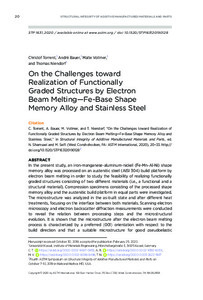| dc.date.accessioned | 2024-02-14T16:37:56Z | |
| dc.date.available | 2024-02-14T16:37:56Z | |
| dc.date.issued | 2020-09-22 | |
| dc.identifier | doi:10.17170/kobra-202402139579 | |
| dc.identifier.uri | http://hdl.handle.net/123456789/15471 | |
| dc.language.iso | eng | |
| dc.publisher | ASTM International | |
| dc.rights | Urheberrechtlich geschützt | |
| dc.rights.uri | https://rightsstatements.org/page/InC/1.0/ | |
| dc.subject | additive manufacturing | eng |
| dc.subject | shape memory alloy | eng |
| dc.subject | austenitic steel | eng |
| dc.subject | functionalized structures | eng |
| dc.subject | secondary recrystallization | eng |
| dc.subject.ddc | 600 | |
| dc.subject.ddc | 660 | |
| dc.title | On the Challenges toward Realization of Functionally Graded Structures by Electron Beam Melting—Fe-Base Shape Memory Alloy and Stainless Steel | eng |
| dc.type | Konferenzveröffentlichung | |
| dcterms.abstract | In the present study, an iron-manganese-aluminum-nickel (Fe-Mn-Al-Ni) shape memory alloy was processed on an austenitic steel (AISI 304) build platform by electron beam melting in order to study the feasibility of realizing functionally graded structures consisting of two different materials (i.e., a functional and a structural material). Compression specimens consisting of the processed shape memory alloy and the austenitic build platform in equal parts were investigated. The microstructure was analyzed in the as-built state and after different heat treatments, focusing on the interface between both materials. Scanning electron microscopy and electron backscatter diffraction measurements were conducted to reveal the relation between processing steps and the microstructural evolution. It is shown that the microstructure after the electron beam melting process is characterized by a preferred 〈001〉 orientation with respect to the build direction and that a suitable microstructure for good pseudoelastic performance can be realized by post-processing heat treatments. Finally, incremental strain tests up to 12% compressive strain were conducted to analyze the overall mechanical performance of the specimens. | eng |
| dcterms.accessRights | open access | |
| dcterms.creator | Torrent, Christof Johannes Jaime | |
| dcterms.creator | Bauer, André | |
| dcterms.creator | Vollmer, Malte | |
| dcterms.creator | Niendorf, Thomas | |
| dc.publisher.place | West Conshohocken, PA | |
| dc.relation.doi | doi:10.1520/STP163120190128 | |
| dc.subject.swd | Rapid Prototyping <Fertigung> | ger |
| dc.subject.swd | Memory-Legierung | ger |
| dc.subject.swd | Austenitischer Stahl | ger |
| dc.subject.swd | Rekristallisation | ger |
| dc.subject.swd | Elektronenstrahlschmelzen | ger |
| dc.subject.swd | Funktioneller Gradientenwerkstoff | ger |
| dc.subject.swd | Mikrostruktur | ger |
| dc.type.version | publishedVersion | |
| dcterms.event.date | 2020 | |
| dcterms.event.place | National Harbor, Md. | |
| dcterms.source.collection | Structural Integrity of Additive Manufactured Materials and Parts | eng |
| dcterms.source.editor | Shamsaei, Nima | |
| dcterms.source.editor | Seifi, Mohsen | |
| dcterms.source.identifier | doi:10.1520/STP1631-EB | |
| dcterms.source.identifier | eisbn:978-0-8031-7709-3 | |
| dcterms.source.identifier | isbn:978-0-8031-7708-6 | |
| dcterms.source.pageinfo | 20-33 | |
| dcterms.source.series | Selected technical papers / ASTM International | eng |
| dcterms.source.volume | STP 1631 | |
| kup.iskup | false | |
| dcterms.event | ASTM International Symposium on the Structural Integrity of Additive Manufactured Materials and Parts, 4; ASTM Symposium on Structural Integrity of Additive Manufactured Materials and Parts, 4 | eng |

